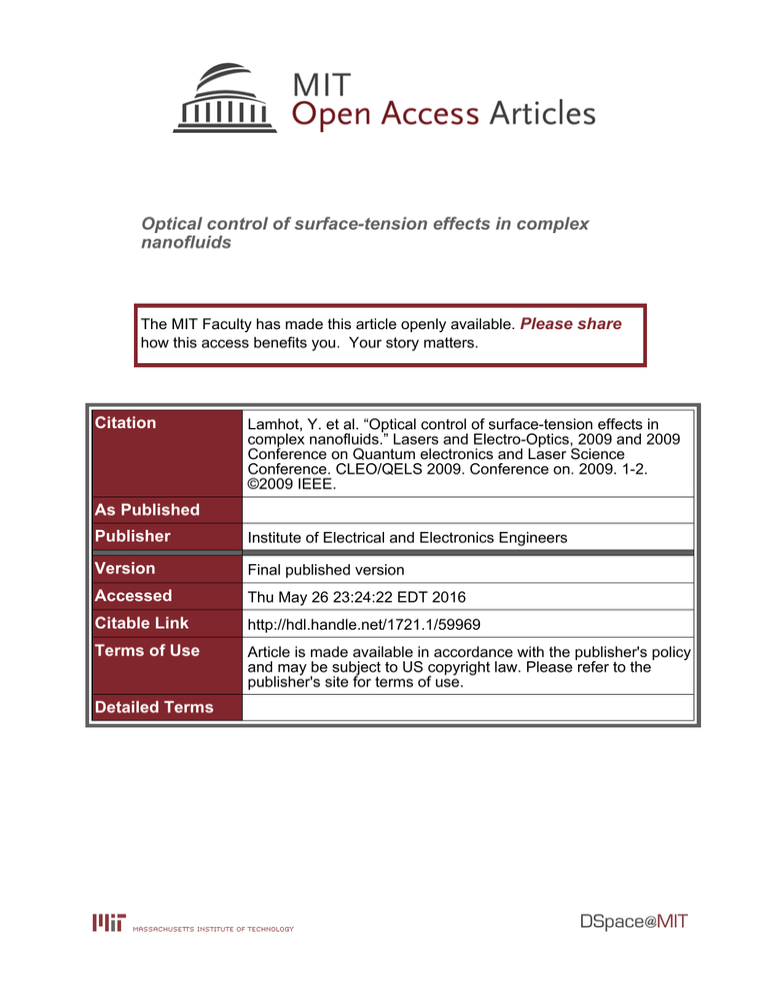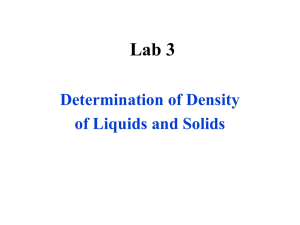Optical control of surface-tension effects in complex nanofluids Please share
advertisement

Optical control of surface-tension effects in complex nanofluids The MIT Faculty has made this article openly available. Please share how this access benefits you. Your story matters. Citation Lamhot, Y. et al. “Optical control of surface-tension effects in complex nanofluids.” Lasers and Electro-Optics, 2009 and 2009 Conference on Quantum electronics and Laser Science Conference. CLEO/QELS 2009. Conference on. 2009. 1-2. ©2009 IEEE. As Published Publisher Institute of Electrical and Electronics Engineers Version Final published version Accessed Thu May 26 23:24:22 EDT 2016 Citable Link http://hdl.handle.net/1721.1/59969 Terms of Use Article is made available in accordance with the publisher's policy and may be subject to US copyright law. Please refer to the publisher's site for terms of use. Detailed Terms © 2009 OSA/CLEO/IQEC 2009 a2396_1.pdf IMG2.pdf IMG2.pdf Optical Control of Surface-Tension Effects in Complex Nanofluids Y. Lamhot1, Costa H. Gurgov1, A. Barak1, M. Segev1, C. Rotschild2, M. Saraf3, E. Lifshitz3, and D.N. Christodoulides4 1. Physics Department, Technion, Haifa 32000, Israel 2. Electrical Engineering Department, MIT 3. Chemistry Department, Technion, Haifa 32000, Israel 4. CREOL – College of Optics, University of Central Florida Email: lamhot@tx.technion.ac.il Abstract: We study coupling between light and nano-particle suspensions, through surface-tension effects in capillaries. Increasing light intensity far-away from the interface causes huge changes in the fluid level, manifesting optical control over mechanical properties of fluids. © 2009 Optical Society of America OCIS codes: (240.4350) Nonlinear optics at surfaces; (240.6648) Surface dynamics; (160.4236) Nanomaterials Until recently, the field of opto-fluidity addressed the integration of fluidics and photonics by utilizing optical properties of various materials in order to perform different localized functions upon illumination [1]. During the past few months, however, our group has demonstrated experimentally that light beams can be used to manipulate the mechanical properties of fluids, demonstrating the ability to move bulks of liquid by light alone [2]. The current work is dedicated to study light-induced surface-tension effects. Until recently, using light to affect surface deformations was possible only by direct illumination of the surface through momentum transfer [3] or via a heating mechanism [4]. Here, we study experimentally the strong interactions between light and suspensions of dielectric nano-particles from very far away from the interface, and demonstrate optical control over the mechanical properties of the fluid. We show that, varying the light intensity causes a huge change (~2mm) in the height of the fluid in a capillary, even when the light beam is far way (~4mm) from the surface. As such, the nonlinear interaction between light and the complex fluid exhibits highly nonlocal effects. The light-induced drop in the height of the fluid in the capillary is driven by a beam whose diameter (~5 µm) is three orders of magnitude smaller than its distance to the interface, yet increasing the beam intensity causes a proportional height drop of up to 2mm. We study this lightinduced surface-tension effect, and its dependence of various parameters such as the beam intensity, distance of the beam from the surface, concentration of nano-particles, and size of the fluid reservoir at the base of the capillary. The vision is to facilitate an accurate optical means to manipulate and control the surface-tension of a fluid. We use a ~5µm FWHM Gaussian beam of vacuum wavelength of 514 nm. Dielectric nanoparticles are prepared in an Octadecene solution, with an initial concentration of the colloidal dispersion of ~1.35·1016 cm-3. A liquid reservoir is filled to a certain volume, with the colloidal dispersion and a Pyrex capillary (670 µm diameter) placed inside it [Fig. 1A]. The reservoir is positioned so that the waist of the beam is inside the capillary below the meniscus. The position of the beam waist is determined by the fluorescent nature of the nanoparticles, as seen in Fig. 1B. The beam and the meniscus are imaged to a CCD camera, where we measure the distance between them [Figs. 1B and 1C]. Meniscus Laser Beam (B) Capillary (A) (C) ∆X0 (D) (E) (d,e,f) ∆H (c) Fluid Reservoir (b) (a) Laser beam initial final Fig. 1. (A) Schematic depiction of the experiment. (B,C) A capillary with nanoparticle fluid illuminated by a narrow laser beam far away from the interface, before (B) and after (C) the change in meniscus height. (D) Meniscus height change as a function of beam intensity, for distance from the surface, ∆X0, of 0.8 and 1.5 mm. (E) Meniscus height change as a function of ∆X0, for various laser intensities. 978-1-55752-869-8/09/$25.00 ©2009 IEEE © 2009 OSA/CLEO/IQEC 2009 a2396_1.pdf IMG2.pdf IMG2.pdf We measure the meniscus height drop, ∆H, as a function of the initial distance from the surface, ∆X0 [defined in Figs. 1B and 1C]. Figures 1D and 1E present the surface response for different intensities and ∆X0, showing that ∆H increases with light intensity, and saturates at high intensities (~400 mW) [Fig. 1D]. The effect is stronger at lower ∆X0. We also find that, when ∆X0 decreases, ∆H increases linearly, irrespective of the beam intensity [Fig. 1E]. The characteristic time for the movement of the surface is on the scale of several seconds, and does not change for hours after reaching the final position. Similar experiments with pure Octadecene fluid show no change in the meniscus at intensities of several watts, even when illuminating close to the surface for extended periods of time. (A) (B) (e) (d) (b) (a) (f) (c) Fig. 2. (A) Meniscus height drop as a function of original distance, for nominal fluid concentration and diluted concentration. (B) Meniscus height drop as a function of original distance, at fluid reservoir volume of 0.5 and 1.5 ml. Next, we examine the effects of particle concentration and the volume of the liquid reservoir on the behavior of the surface. To study the effect of the concentration, the fluid is diluted using pure Octadecene to decrease the particle concentration to half its nominal value. Figure 2A presents ∆H vs. ∆X0 for diluted (lines a,c and e) and nominal fluid (lines b, d and f). As shown, ∆H decreases with particles concentration (for example, lines a and b). The same trend is observed when the volume of the fluid reservoir at the base of the capillary is enlarged (Fig. 2B). In order to understand the behavior of the surface, similar experiments are preformed with a thin Tungsten wire wrapped around the capillary, heating the fluid locally. The wire is covered with thermal conducting paste to ensure good thermal coupling with the capillary. The wire is connected to a tunable voltage source, and a thermocouple is attached, monitoring the temperature. When the wire is heated to 50o C, the meniscus drops slowly (on a time scale of tens of minutes), settling at the same level as the wire. This behavior does not depend on the distance from the surface, and is observed in both nanoparticle dispersion and in pure Octadecene, thus proving that the origin of the optical effect on surface-tension is not strictly thermal. Subsequently, we measure the liquid-air surface tension using pendant drop. The measurements are carried out for pure Octadecene and for the nominal and diluted nanoparticle fluid, at 23o C and at 28o C, as listed in Table 1. We find that, by lowering the concentration of the particles, the surface tension strongly increases. Particle concentration [cm-3] Table 1. Liquid-air surface tension 0 3.40·1015 1.35·1016 1.35·1016 Surface Tension [mN/m] 28.0 24.1 21.2 21.1 Temperature o o o 28o C 23 C 23 C 23 C The dependence of the surface tension and the height drop, ∆H, on the concentration of the particles points to the fact that, when the fluid is illuminated – even far away from the surface - the nanoparticles redistribute. Specifically, the density of nano-particles changes also at the vicinity of the surface, thus modifying surface-tension, and leading to a very large change in the height of the fluid in the capillary. That is, light is causing major changes in the mechanical properties of the fluid surface, even when the illumination is very far away from the surface. To summarize, we have demonstrated experimentally long-range optical control over surface-tension effects in nanoparticle suspensions. References: [1] D. Psaltis, S.R.Quake, and C. Yang, Nature (London) 442, 381 (2006). [2] C. Rotschild, et al., in Conference on Lasers and Electro-Optics/Quantum Electronics and Laser Science Conference and Photonic Applications Systems Technologies, OSA Technical Digest (CD) (Optical Society of America, 2008), paper CPDA4. [3] A. Casner, and J.-P. Delville, Phys. Rev. Lett. 90, 144503 (2003). [4] M. Dietzel, and D. Poulikakos, Phys. Fluids 17, 102106 (2005).


